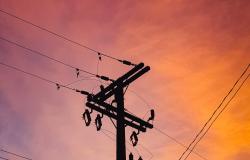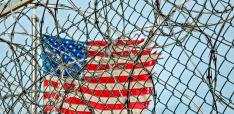Requiem for a Dying Hegemon

Scott Montgomery worries that America's crumbling energy infrastructure is a sign of its waning global status.
I have been standing on a sidewalk, studying a telephone pole. It looks to be old, perhaps 50 years or more, and the creosote that once coated and preserved it has long worn off and gone to pollute the sediments of a nearby lake. The top of the pole has been beaten by decades of weather, whipped by wind, eroded to look like a broken tooth. Below, the wood is bleached and cracked, with jagged pieces flaking and scaling off. Insulation on the wires is worn, and the transformer casings are nearly rusted through in several places. A set of secondaries (wires to a home) attached to a crossarm have pulled the arm downward to resemble the slanting portion of an Eastern Orthodox cross. There is no overhead ground wire, and a ceramic insulator on the larger transformer is chipped. Replacement is decades overdue. The situation is potentially dangerous but not critical.
It may seem quaint that a pole like this would be exchanged by another of its kind. Wood—or, more accurately, a once-living organism from a tree farm—was the material used in the earliest days of electricity, 140 years ago. The rest of the world has largely moved on, either using steel, cement, fiber composite, or burial underground. Some of this is employed locally in the U.S., but in most areas, including my city—one of the wealthiest High-Tech hubs in the nation—the pattern remains new wood for old.
A charming loyalty to historical origins? Skepticism is warranted; not everyone views ageing poles and wires as an aesthetic blessing. They are, however, absolutely elemental to America’s grid system. Tree-farm wood is used because it is cheaper, therefore affordable in the country’s tax-poor cities. Even so, it seems not to be cheap enough to make overdue replacements, which now likely number in the millions (the U.S. has over 150 million utility poles).
Aging poles and electrical parts are a core vulnerability for the grid. Extreme weather and flooding have been on the increase in large portions of the country, as have heat waves, all due to climate change and therefore due to get worse. Powerful storms do not need overhanging tree limbs to bring down wires; floods saturate the basal wood of a pole causing rot (wet and dry), while also washing away soil and carrying flotsam able to impact and injure any standing structure.
Costs and Benefits
Between 2000 and 2012, the number of power outages in the U.S. went up many-fold.
Duration of blackouts has also continued to climb. Here I am supposed to note how much all this has cost. But I won’t, not because I think it’s unimportant, but because it skews the argument. A report on this problem for the Congressional Research Service (an informational arm that serves Congress), mentions several solutions: better trimming of nearby trees; putting wires underground; making Smart Grid improvements; adding distributed power generation. Then comes the punchline: all of these “come with high costs which must be balanced against the perceived benefits.”
At some point in the past, these “benefits” were perceived to include public well-being and security. Today, with the penetration of digital technology and internet use into every part of daily life, including government, they would also include national security and social stability. Such things, as I say, were once “benefits” worth serious investment. “Costs” were a concern worth bearing, since people’s safety, health, and quality of life were primary considerations. We know this, those of us old enough to remember, because we saw large infrastructure projects being built, completed, and maintained before our eyes—highways, roads, sidewalks, bridges, community centers, public transport, and, yes, utility poles.
The ideas behind this effort, particularly that of “the common good,” were largely thrown out, like bath water, by the advent of conservative thinking and policies that turned away from such investment as the sign of “burdensome taxes” and “excessive government power.” Privatization of public goods has been another principle, of course. For electricity, this has meant deregulation and a disappearance of transparency about what private utilities might be doing or not doing to improve their infrastructure. Such thinking, in both concentrated and dilute forms, has held sway to the present, but nowhere more rigidly than in the U.S.
Playing with Fire
It helps to think about things in concrete terms. What happens when the power goes out, say, for a day? No refrigeration for food or drink, no running water (in many cases), no hot water, no heat or air conditioning, no indoor cooking, no appliances working, no charging of electronics, no public transportation (in many cities), no business or commercial operations, no water or sewage treatment, no school, no lights at night. It takes little time for a blackout to evolve from annoyance to threat.
No one should be surprised that this is especially true for poor and minority communities. Such is where electrical infrastructure has been more neglected than anywhere, and where people are more dependent on public welfare services. The truth of this was thoroughly proven by the endgame strategy of California’s largest utility, Pacific Gas & Electric (PG&E), after the northern part of the state suffered the worst wildfire (Camp Fire) in its history in 2018, with 85 people killed (again, no $ figures). Since this originated during a windstorm from a worn and unmaintained high voltage line (a broken suspension insulator), the company decided it had to shut off power the next year to millions of people for up to a week when another period of high wind began. The logic was thus: to protect people (and company liability) from another catastrophic fire, they must be deprived of the most fundamental support for daily life. It would not be negligent to ask in what kind of universe this logic becomes necessary.
PG&E did know that its 18,500 miles of power lines had seriously outdated portions. This had already been made clear by earlier fires and accidents. It knew that such a system needs constant, uncompromised maintenance. It had maintenance policies in place that it didn’t follow. Some of its executives and many of its engineers understood that deferred maintenance in an electricity transmission system creates a distinct threat to public safety. The tower where the failure took place, causing the Camp Fire, was 99 years old, a quarter-century past its replacement date. A full-scale inspection of its transmission system after the fire revealed more than 1,200 safety problems, many in high-risk fire areas, and no fewer than 10,000 required repairs. The company says that a decade is needed to do this work. In the meantime, the policy of preemptive blackouts will likely, if selectively, proceed.
The future of the U.S. grid, to put the matter diplomatically, is uncertain. I have been reading a new National Academy of Sciences (NAS) report on the findings of a high-level workshop about this very subject. It is part of a series the NAS is conducting on “The Future of Electric Power in the U.S.” Because I teach and do research on energy and security, this is of great interest. After exploring what the Academy has planned and reading the mentioned report, I am a bit stunned. Perhaps I have missed it; but no. Nowhere does there seem to be consideration for the actual physical state of the grid. The report, in fact, repeatedly claims that: “[O]ur infrastructure is largely safe and reliable due to the significant investment our utilities have made.”(15) The real worry, it says, is vulnerability to cyberattack from foreign adversaries like Russia and China.
Reading this in the wake of the California wildfires adds credence to the concept of multiple universes. In the one where most people live, the American Society of Civil Engineers has given a D+ grade to the U.S. electricity system, pointing to more than 3,500 outages in just one year (2016). If we add in dams, including those for hydropower (~2,400), the grade drops to a D. There can be no doubt that cybersecurity defines a real threat to grid security. Yet its true role is additive.
At this point, I can only assume that more serious disasters and deaths will be needed for any real improvements at scale. From nature’s point of view, this is not a problem. A warming atmosphere, with more thermal energy available for storms, will take care of the need in a decade or two.
Can It Be Done?
In my city, Seattle, dozens of glossy new buildings with commercial, business, and residential space have gone up in less than a decade, some with curving architecture and alluring detail. Yet the streets that lie below these gleaming structures are, in many places, in such terrible condition that riding a bike becomes a perilous adventure. In every neighborhood of this very wealthy city, the sidewalks are cracked and shattered, alleyways pitted and fissured, gas lines invisibly leak, storm drains are often choked, curbs are chipped and worn, street names bent, parks desperate for care.
We have been trained to look for the signs of decay in things like burnt out buildings, dilapidated homes, gang graffiti, spreadings of garbage. There is little of this here. In America’s tax-poor cities, the signs of failure are different, deeper in a sense because ubiquitous, worse in poorer neighborhoods to be sure but present everywhere. What seems most remarkable is how unremarkable it all is, how ordinary. People have grown used to it (I am no exception) to the point where it is invisible. In the midst of a pandemic, an economic collapse, a long-awaited and greatly needed movement for racial justice, the empire silently turns to dust.
But wait. Hasn’t Joe Biden, Democratic candidate in the presidential election this fall—with a rising chance of victory, it seems—come forth with a $2 Trillion “clean energy and infrastructure plan” to “build back” America from its deteriorated state? Yes, he has, and it is welcome. If it has emerged from the cauldron of political considerations (the progressive vote), no matter, as long as he is serious about it.
That being said, what are its goals? Carbon-free power by 2035, all cities over 100,000 given “quality” public transport by 2030, broadband access for every American, a rebuilding of roads, bridges, water systems, and, not least, a full-scale upgrade of the grid to “smart” status. There is more, too, but no need to be complete. The point seems clear: this is a list of needs, not possibilities. Not one of them is likely to be achievable in the time frame posed, given the America of today. Even Mr. Biden’s budget seems impossibly low, by an order of magnitude; estimates for upgrading the grid alone are now in the realm of $5 trillion. True, it is the business of presidential campaigns to promise big things. But the vision of U.S. consensus and national accord embodied in these goals is so exaggerated, even prodigal, that it merits a sigh.
Oh ye of little faith! But no, this comes from the gospel of suffered experience. Has not Mr. Trump endowed us with the holy wisdom that the programs and worthy intentions of one administration can be annihilated by another? The Biden Plan, realistically speaking, like the Green New Deal before it, can begin a major course correction, not achieve it. No president (who has neglected to alter the constitution) can pledge the future beyond their own term, let alone during it. Were the Democrats to sweep the elections this year, the Biden Plan would still not launch without many compromises and mitigations from Congress. The party is hardly unified on such fundamental issues. Indeed, it took Mr. Biden himself many months and reproaches from activists to go so far to the progressive side.
Then there are the small facts. First, the tens of millions of voting Americans who continue to support Trump and far-right views about the climate, taxes, the evils of liberalism, and false truths of science. Second, that Republicans, most of whom profess similar views, continue to control 29 state legislatures, compared with 19 for Democrats. This is meaningful, since state and local government will have much say about how any infrastructure effort will be carried out. These realities, too, might give one pause.
How to Define a Dying Hegemon
I do not point this out to banish hope or ambition for a better era. I have children who will have children. But having watched the country descend over decades to where a man like Donald Trump—the breathing antithesis to everything the Founders wished for in a president—entered the White House, I accept that deep change will be needed for the U.S. to rebuild itself. This will be a change in ideas, including a driving out of the spectacularly damaging belief that government is the enemy of all that is worthy and that something called “the common good” is more than a contradiction in terms.
For the time being, the U.S. will continue life as a dying hegemon. No more proof of this is needed than the astonishing, discouraging, and lethal incompetence of America’s response to the Covid-19 pandemic. Refusal to accept the disease as a real and growing public threat has extended from the White House down to a number of governors and many local authorities. Conspiracy theories, fact denial, politicization, and more have been responsible for the deaths of dozens, even hundreds, rendering parts of the country the equivalent of medieval towns facing the arrival of Yersinia pestis in 1347. What kind of America would need to exist for little of this to happen?
A dying hegemon is a nation able to build world-ending nuclear weapons but that cannot provide enough masks to its citizens. It is a realm of immense wealth and vast resources where millions are hungry and life expectancy has fallen. Finally, it is a place ruled by those who angrily and routinely invoke the fearful threats from foreign adversaries, while allowing the aged and broken bones of its infrastructure to remain unattended.
As for the telephone pole with which we began, I can only view it as something like a ruin avant la letter. It is standing there, still doing its work, a part of the contemporary world, but as a sign of a great power that will soon be no more.
Photo by Jonas Ferlin from Pexels

